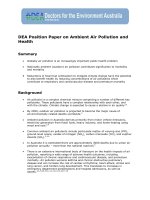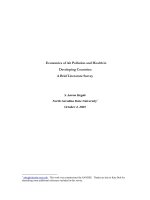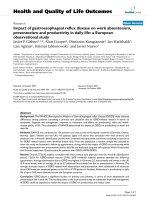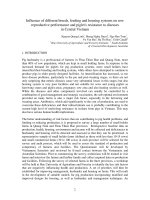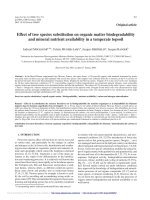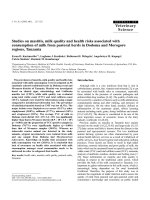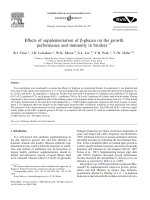Effect of housing on general behaviour, performance and health of dairy animals - A review
Bạn đang xem bản rút gọn của tài liệu. Xem và tải ngay bản đầy đủ của tài liệu tại đây (138.33 KB, 6 trang )
Int.J.Curr.Microbiol.App.Sci (2020) 9(2): 2823-2828
International Journal of Current Microbiology and Applied Sciences
ISSN: 2319-7706 Volume 9 Number 2 (2020)
Journal homepage:
Review Article
/>
Effect of Housing on General Behaviour, Performance and
Health of Dairy Animals-A Review
Komal1, Sweety2, Veenesh Rajpoot3 and Man Singh1
1
Department of Livestock Production Management, LUVAS, Hisar, India
Department of Veterinary Physiology & Biochemistry, LUVAS, Hisar, India
3
Livestock Production Management, National Dairy Research Institute, Karnal, India
2
*Corresponding author
ABSTRACT
Keywords
Calves, health,
behaviour, social
Article Info
Accepted:
20 January 2020
Available Online:
10 February 2020
Social facilitation defined as initiation of a particular response while
observing others engaged in that behavior. Contact with the dam or other
older animals within the first few weeks of life able to learn young animals
to start sampling solid feeds and to eat. Social facilitation and social
learning may result in higher intake of solid feed and improved body
weight gains compared with individually housed calves. Many researchers
reported that calves housed in group showed more eating and lying time but
lesser abnormal behaviour like cross-sucking, self- licking, tongue rolling
etc. Group housed calves performed more health problems mainly,
diarrhea, respiratory as compared to individual housed calves. After
weaning, socially housed calves performed better as compared to
individually housed calves. So overall, social environment is must for
overall development and welfare of calves.
Introduction
Effect of housing on general behaviour of
calves
Mahmoud and Darwish. (2018) found that
buffalo calves housed in pair group showed
more (P≤0.05) eating and drinking,
chewing/ruminating, object manipulation and
self-grooming, lying activities, and less
(P<0.05) inactivity and standing compared to
when calves housed in individual and group.
Vieira et al., 2010 also observed that paired
calves had a shorter latency to start feeding,
visited the starter feeder more frequently,
spent more time at the feeder, and consumed
more starter than individually housed calves.
Calves that were housed in pair and receiving
high milk allowance spent more time feeding
than did those housed singly and receiving the
similar milk allowance (Duve et al., 2012).
2823
Int.J.Curr.Microbiol.App.Sci (2020) 9(2): 2823-2828
Further 2 calves/pen were more engaged in
eating, drinking, chewing and ruminating
more than calves in groups of 4 or 8
(Abdelfattah et al., 2013). This may be due to
increased social interaction among calves in
groups, which may be resulted in increased
the speed of diet consumption, thereby
reducing eating and drinking time. Group
housed calves spent more time eating solid
feeds (19.3 versus 14.4) minutes with
relatively higher dry matter consumption
(399±35 gm versus 330±33 gm) than
individual housed calves (Babu et al., 2004).
Tapki, 2007 observed that group housed
showed the increased proportional of playing
events (12.80 vs. 2.86%), walking (19.14 vs.
3.81%) and grooming (8.06 vs. 4.60%), but
decreased licking objects (1.03 vs. 2.94%),
idle standing (20.73 vs. 36.29%), lying (30.19
vs. 39.53%) and restlessness (1.69 vs. 3.47%)
compared to individual housing systems
(p<0.001).
Self-grooming
and
object
manipulation activities were significantly
higher in pair than 4-8 group housed calves
(Abdelfattah et al., 2013). Latter Mahmoud
and Darwish., 2018 reported that object
manipulation and self-grooming activities in
pair group calves were significantly higher
than those kept in group. This may be due to
social deprivation which may be enhanced the
non-nutritive oral activities in dairy calves. In
contrast to this Chua et al., (2002) observed
no differences in the amount of time spent on
self-grooming between individually and pairhoused calves.
The time spent for idle standing activities in
individual housing were more than group
housing (Babu et al., 2004). Standing
activities in group were significantly higher
than those recorded in pair housed (Mahmoud
and Darwish., 2017). Abdelfattah et al.,
(2013) observed that calves housed in groups
of 4 and 8 stood more compared to pairs
housed calves, and this was due to availability
of free space which gives an opportunity for
calves to stand and walk more. This is
already proposed that calves housed together
in a pen moved more easily than housed in
individual stalls because they can walk
together around the pen and lie down close to
other calves leaving space for others to
remain standing (Veissier et al., 1997). But in
contrast Chua et al., (2002) and Vieira et al.,
(2012) reported that pair-housed calves spent
more time standing than individually housed
calves.
Abdelfattah et al., (2013) found that calves
housed in pairs observed lying more than
groups contain 4 and 8 calves because of
greater social interaction between calves and
disturbance from pen-mates in group housed
animals. Mahmoud and Darwish (2017)
observed that lying behavior patterns in pair
housed were significantly higher than those in
individual and group housed. However, in
contrast Chua et al., (2002) observed no
significant differences in the lying down time
between individually or pair housed calves.
Whereas Babu et al., (2004) found that the
time spent for sleeping/lying activities in
individual housing were more than in group
housing.
Effect of group housing on feed intake and
body weight gain of calves
It was found that grass intake and time spent
on grazing were greater for grouped calves
than for individual calves (Phillips, 2004) and
it was also found that raising calves in groups
increased concentrate consumption and the
early onset of rumination compared to
individual rearing (Babu et al., 2003, 2004).
Bernal- Rigoli et al., (2012) found that DMI
was greater for group housed calves after 41
days of age, resulting in greater BW gains for
group-housed calves. Similarly, pair housing
of dairy calves has been associated with
increased solid feed intake (Jensen et al.,
2824
Int.J.Curr.Microbiol.App.Sci (2020) 9(2): 2823-2828
2015). Group housed calves increased their
calf starter intake (37.35±1.24 kg vs.
23.39±0.86 kg; p<0.001), alfalfa hay intake
(8.76±0.35 kg vs. 7.14±0.43 kg; p<0.05) and
total feed intake (46.11±1.04 kg vs.
30.53±0.86 kg; p<0.001) compared to
individual housed calves. Group housed
calves showed increased body weight gain by
about 2.36 kg and body length by about 1.48
cm per calf compared to those kept in
individual pens (p<0.05) (Tapki, 2007).
Most recently, it was shown that pair housing
of calves starting in the first week of life
increased calf feed intake and weight gains
compared to individual housing and pairing
calves at 6 wk of age (Costa et al., 2015).
Calves that were group housed early in life, in
addition to having increased solid feed
intakes, also showed reduced behavioral
responses to mixing and weaning (Chua et al.,
2002; Vieira et al., 2012a,b). Calves reared in
groups continue to get benefit from higher
concentrate intake than calves previously
reared individually, even after all calves are
mixed in group pens at later stage (Vieira et
al., 2010). Such effects that persist beyond the
period of individual housing might be due to
the better learning abilities of socially housed
calves described above, allowing them to
learn more rapidly where and how to use new
feeders.
Duve et al., (2012) found that group-housed
calves were faster at locating feed and spent
more time eating concentrates in competitive
situations than did calves that had been
individually housed; these findings are
consistent with the interpretation that intake
differences persisting beyond the period of
individual rearing are due in part to cognitive
deficits.
In addition, preweaning intake of solid feed
helps to improve the transition from milk to
solid feed at weaning (Weary et al., 2009),
such that calves that do not achieve adequate
solid feed intakes before weaning experience
poor growth and in Bull calves that were
reared in groups also gained weight more
rapidly than individually housed calves
(Andrighetto et al., 1999; Xiccato et al.,
2002). Other work has shown the advantages
of early gains during the milk-feeding period
on the later weight gains of older heifers
(Bond et al., 2015). Early gains also have
positive effects on the onset of puberty and
milk production in the first and later lactations
(Moallem et al., 2010; Soberon et al., 2012).
A similar line of research has shown that
Holstein bull calves reach puberty earlier and
have larger testicular mass when offered a
high plane of nutrition early in life (Dance et
al., 2015). Thus, early growth achieved in the
first weeks of life can have profound effects
on production and reproduction later in life.
Pempek et al., (2016) investigated the effect
of pair housing on the behavior and growth
performance. They found that Calves housed
in pairs tended to have greater average daily
gain compared with calves housed
individually (0.63 vs. 0.59 ± 0.02 kg/d,
respectively). Pair housing also increased
final body weight compared with individual
housing (64.9 vs. 61.7 ± 0.59 kg,
respectively). During observation periods,
calves housed individually spent more time
engaging in non-nutritive sucking than calves
housed in pairs (21.5 vs. 8.15 ±0.03% of total
observations).
Bolt et al., (2017) assessed the effects of
varying degrees of social contact on weaning
stress, health and production during pen
rearing, and on the social networks that calves
later formed when grouped. They recorded
the vocalisations as a measure of stress for
three days before, during and after weaning.
Vocalisations were highest post-weaning, and
were significantly higher in Individual group
calves than pair-reared calves. Furthermore,
2825
Int.J.Curr.Microbiol.App.Sci (2020) 9(2): 2823-2828
pair housed from day 28 calves vocalised
significantly more than pair housed from day
5 calves. Abdelfattah et al., (2018) found that
grouping at 3rd, 7th and 14th day did not affect
final BW, BW gain, or ADG (F2, 26 = 3.99, P
> 0.05). Average daily gain (mean ± SE) was
similar among treatment groups (0.8± 0.04,
0.7 ± 0.04, and 0.7 ±0.04 kg/d for GH3, GH7,
and GH14, respectively, F2, 27 = 1.02, P =
0.49).
Effect of housing on health condition of
animals
Curtis et al., (2018) reported that during the
pre-weaning phase group housed calves had a
greater risk of disease occurance (diarrhoea:
odds ratio 3.86 vs pneumonia: odds ratio
5.80) than individually reared calves. In
contrary to above Abdelfattah et al., (2018)
reported that calf fecal, cough, and nasal and
ocular discharge scores, differential leukocyte
counts, and plasma cortisol concentrations
were not affected by age at grouping.
Effect of housing on behavior and intake at
time of weaning
Overvest et al., (2018) observed that
individually housed and pair-housed calves
experienced behavioral changes around
weaning time which includes increasing
feeding time, solid feed intake, and
decreasing lying time and bout frequency. In
pair housed calves solid feed consumption
was more than (0.96 vs. 0.50 kg/d on d 48)
that of the individually housed calves.
Further pair-housed calves had greater
feeding rates than individually housed calves
(13.4 vs. 6.6 g of DM/min). As advance with
calf age lying time and lying about frequency
decreased during the weaning period across
treatments, and pair-housed calves tended to
spend less time lying than individually housed
calves (1,015 vs. 1,039 min/d) during this
time period. Cushon and DeVries (2016)
reported that concentrate intake of paired
housed calves tended (P = 0.06) to be higher
than that of individually housed calves before
weaning and during the weaning period,
paired housed calves consumed more solid
feed and had greater ADG. Latter on when
calves were offered a choice of social noncompetitive feeding (2 buckets on the side
with the tethered calf) or isolated feeding,
previously paired housed calves preferred to
spend a greater percentage of feeding time on
the social side of the pen than IH calves (F1,8
= 10.70; P = 0.011).
References
Abdelfattah, E. M., Schutz, M. M., Lay Jr, D.
C., Marchant-Forde, J. N. and Eicher,
S. D. (2013). Effect of group size on
behavior, health, production, and
welfare of veal calves. Journal of
Animal Science, 91: 5455-5465.
Andrighetto, I., Gottardo, F., Andreoli, D. and
Cozzi. G. (1999). Effect of type of
housing
on
veal
calf
growth
performance, behaviour and meat
quality. Livest. Prod. Sci. 57: 137–145.
Babu, L. K., Pandey, H. N. and Sahoo, A.
(2003). Effect of individual versus
group rearing and feeding of different
levels of milk and skim milk on nutrient
utilization in crossbred calves. Asianaustralas. J. Anim. Sci. 16: 1455–1459.
Babu, L. K., Pandey, H. N. and Sahoo, A.
(2004). Effect of individual versus
group rearing on ethological and
physiological response of cross-bred
calves. Appl. Anim. Behav. Sci. 87:
177–191.
Bernal-Rigoli, J. C., Allen, J. D., Marchello,
J. A., Cuneo, S. P., Garcia, S. R., Xie,
G. and Duff, G. C. (2012). Effects of
housing and feeding systems on
performance of neonatal Holstein bull
calves. Journal of Animal Science, 90:
2818-2825.
2826
Int.J.Curr.Microbiol.App.Sci (2020) 9(2): 2823-2828
Bolt, S. L., Boyland, N. K., Mlynski, D. T.,
James, R. and Croft, D. P. (2017). Pair
housing of dairy calves and age at
pairing: Effects on weaning stress,
health, production and social networks.
PloS one, 12(1), e0166926.
Chua, B., Coenen, E., Van Delen, J. and
Weary, D. M. (2002). Effects of pair
versus individual housing on the
behavior and performance of dairy
calves. Journal of Dairy Science, 85:
360-364.
Costa, J. H. C., Meagher, R. K., Von
Keyserlingk, M. A. G. and Weary, D.
M. (2015). Early pair housing increases
solid feed intake and weight gains in
dairy
calves. Journal
of
Dairy
Science, 98: 6381-6386.
Curtis, G., Argo, C. M., Jones, D. and GroveWhite, D. (2018). The impact of early
life nutrition and housing on growth and
reproduction in dairy cattle. PloS
one, 13(2):e0191687.
Dance, A., Thundathil, J., Wilde, R., Blondin,
P. and Kastelic, J. (2015). Enhanced
early-life nutrition promotes hormone
production
and
reproductive
development in Holstein bulls. J. Dairy
Sci. 98: 987–998.
Duve, L. R., Weary, D. M., Halekoh, U. and
Jensen, M. B. (2012). The effects of
social contact and milk allowance on
responses to handling, play, and social
behavior in young dairy calves. J. Dairy
Sci. 95: 6571–6581.
Jensen, M. B., Duve, L. R. and Weary, D. M.
(2015). Pair housing and enhanced milk
allowance increase play behavior and
improve performance in dairy calves. J.
Dairy Sci. 98: 2568–2575.
Mahmoud, U. T. and Darwish, M. H. (2018).
Effect of Pair Housing Versus
Individual and Group Housing on
Behavioural Patterns of Buffalo
Calves. Journal of Advanced Veterinary
Research, 8: 12-15.
Moallem, U., Werner, D., Lehrer, H., Zachut,
M., Livshitz,
L., Yakoby, S. and
Shamay, A. (2010). Long-term effects
of ad libitum whole milk prior to
weaning and prepubertal protein
supplementation on skeletal growth rate
and first-lactation milk production. J.
Dairy Sci., 93: 2639–2650.
Overvest, M. A., Crossley, R. E., MillerCushon, E. K. and DeVries, T. J.
(2018). Social housing influences the
behavior and feed intake of dairy calves
during weaning. Journal of Dairy
Science, 101: 8123-8134.
Pempek, J. A., Eastridge, M. L.,
Swartzwelder, S. S., Daniels, K. M. and
Yohe, T. T. (2016). Housing system
may affect behavior and growth
performance of Jersey heifer calves.
Journal of Dairy Science, 99: 569-578.
Phillips, C. J. C. (2004). The effects of forage
provision and group size on the
behavior of calves. J. Dairy Sci. 87:
1380–1388.
Soberon, F., Raffrenato, E., Everett, R. W.
and Van Amburgh, M. E. (2012).
Preweaning milk replacer intake and
effects on long-term productivity of
dairy
calves. Journal
of
Dairy
Science, 95: 783-793.
Tapki, I. 2007. Effects of individual or
combined
housing
systems
on
behavioural and growth responses of
dairy calves. Acta Agric. Scand. A
Anim. Sci. 57: 55–60.
Veissier, I., Chazal, P., Pradel, P. and Le
Neindre, P. (1997). Providing social
contacts and objects for nibbling
moderates reactivity and oral behaviors
in veal calves. Journal of Animal
Science, 75: 356-365.
Vieira, A. D. P., Von Keyserlingk, M. A. G.
and Weary, D. M. (2010). Effects of
pair versus single housing on
performance and behavior of dairy
calves before and after weaning from
2827
Int.J.Curr.Microbiol.App.Sci (2020) 9(2): 2823-2828
milk. Journal of dairy science, 93:
3079-3085.
Vieira, A. D. P., de Passillé, A. M. and
Weary, D. M. (2012a). Effects of the
early social environment on behavioral
responses of dairy calves to novel
events. Journal of Dairy Science, 95:
5149-5155.
Vieira, A. D. P., Von Keyserlingk, M. A. G.
and Weary, D. M. (2012b). Presence of
an older weaned companion influences
feeding
behavior
and
improves
performance of dairy calves before and
after weaning from milk. Journal of
Dairy Science, 95: 3218-3224.
Weary, D. M., Huzzey, J. M. and von
Keyserlingk, M. A. G.(2009). Boardinvited review: Using behavior to
predict and identify ill health in
animals. J. Anim. Sci. 87: 770–777.
Xiccato, G., Trocino A., Queaque, P. I.,
Sartori, A. and Carazzolo, A. (2002).
Rearing veal calves with respect to
animal welfare: Effects of group
housing and solid feed supplementation
on growth performance and meat
quality. Livest. Prod. Sci. 75:269–280.
How to cite this article:
Komal, Sweety, Veenesh Rajpoot and Man Singh. 2020. Effect of Housing on General
Behaviour, Performance and Health of Dairy Animals-A Review. Int.J.Curr.Microbiol.App.Sci.
9(02): 2823-2828. doi: />
2828
